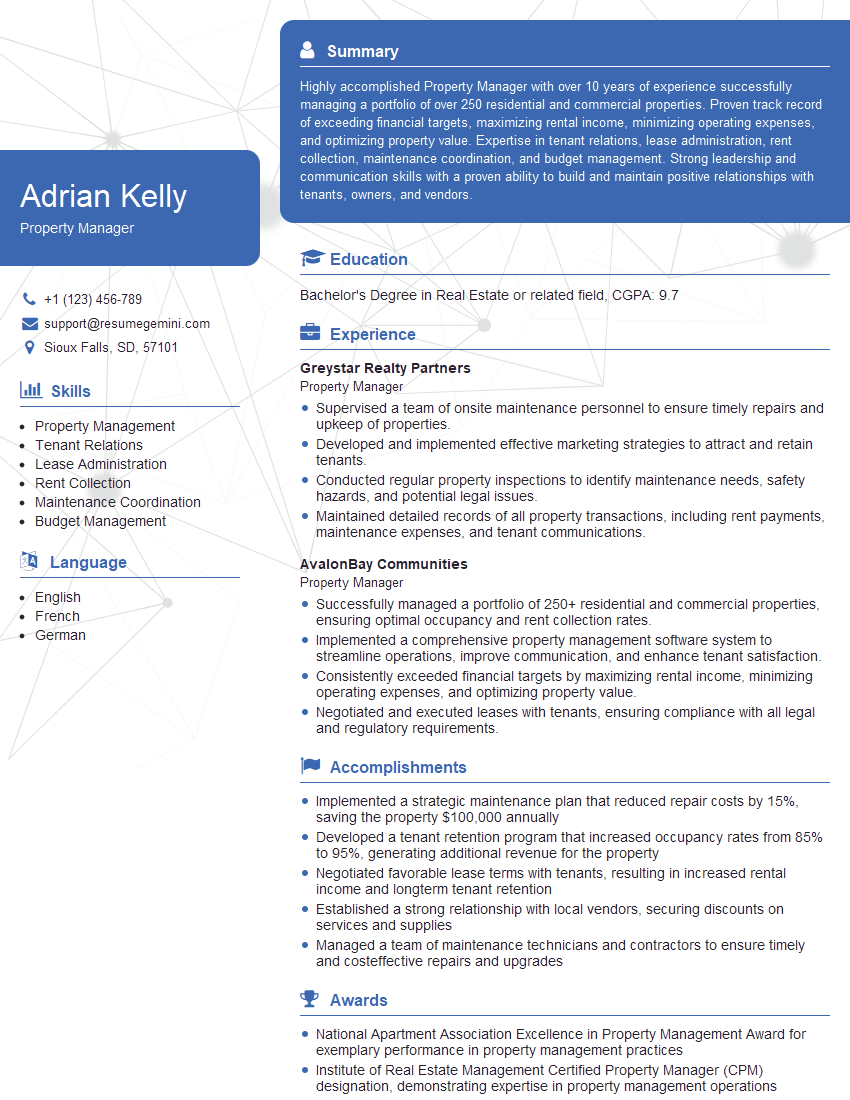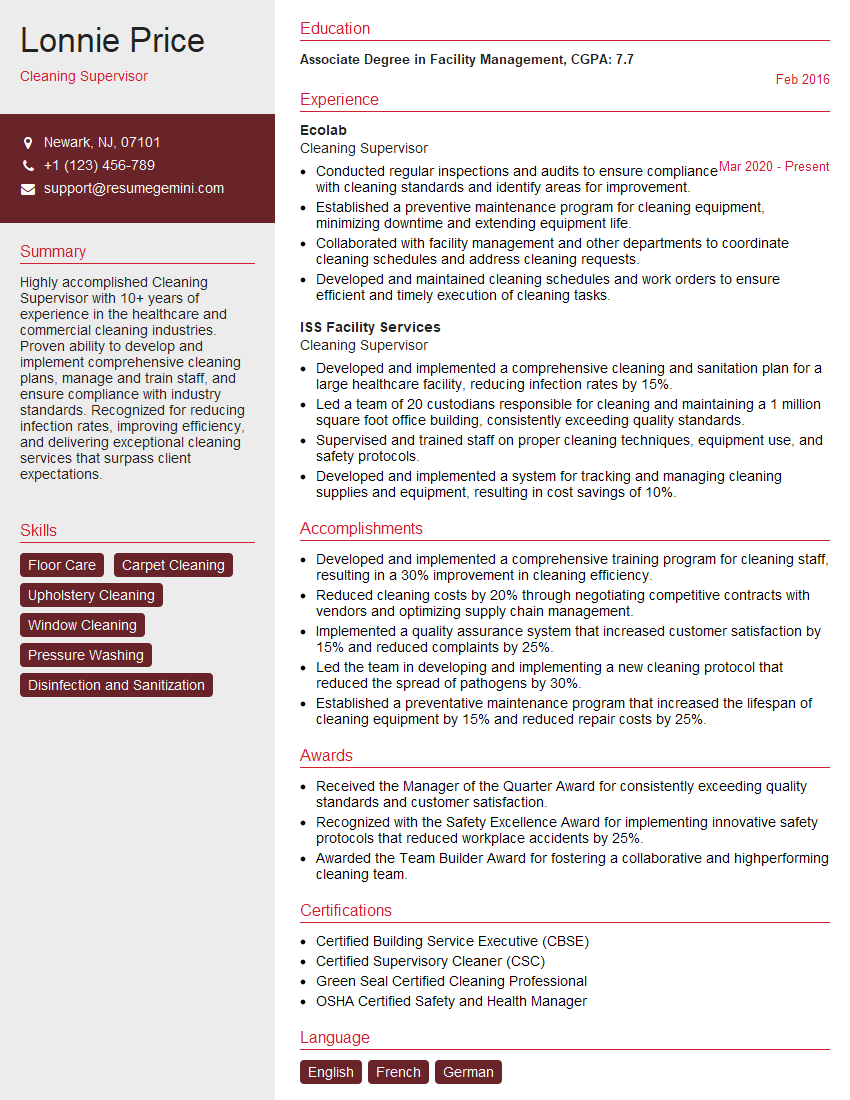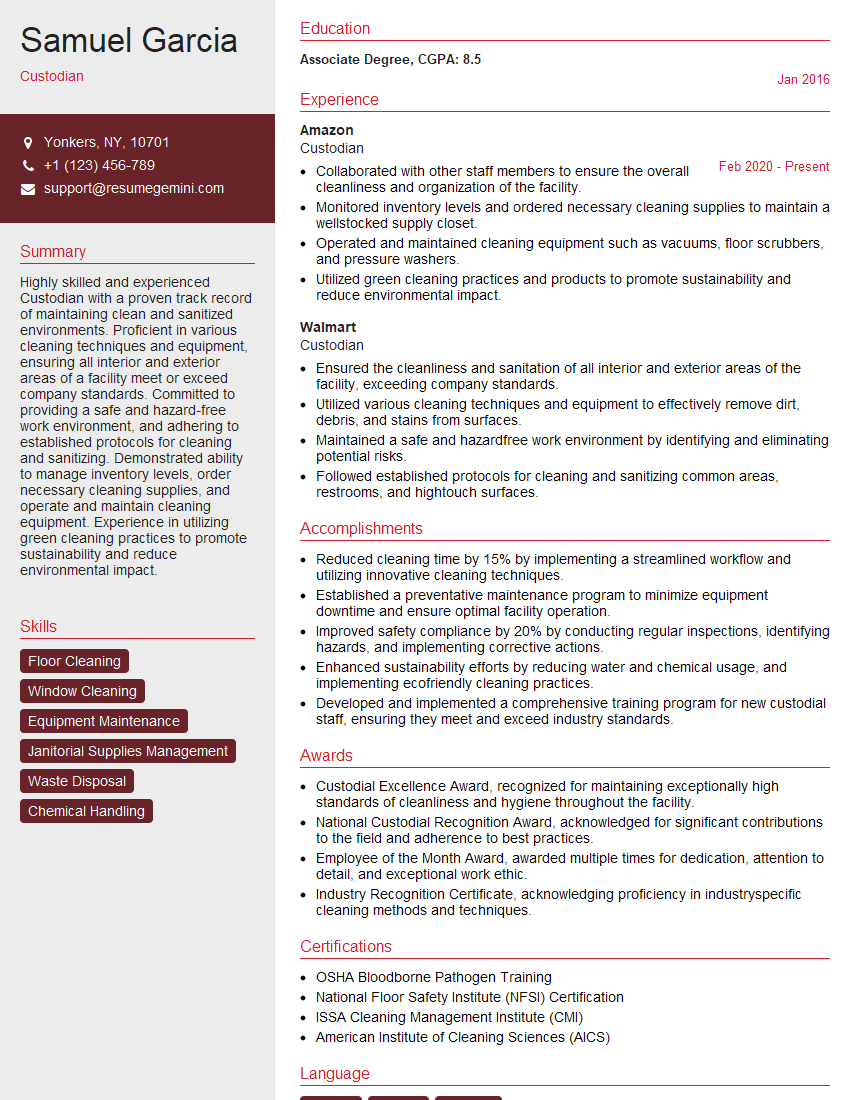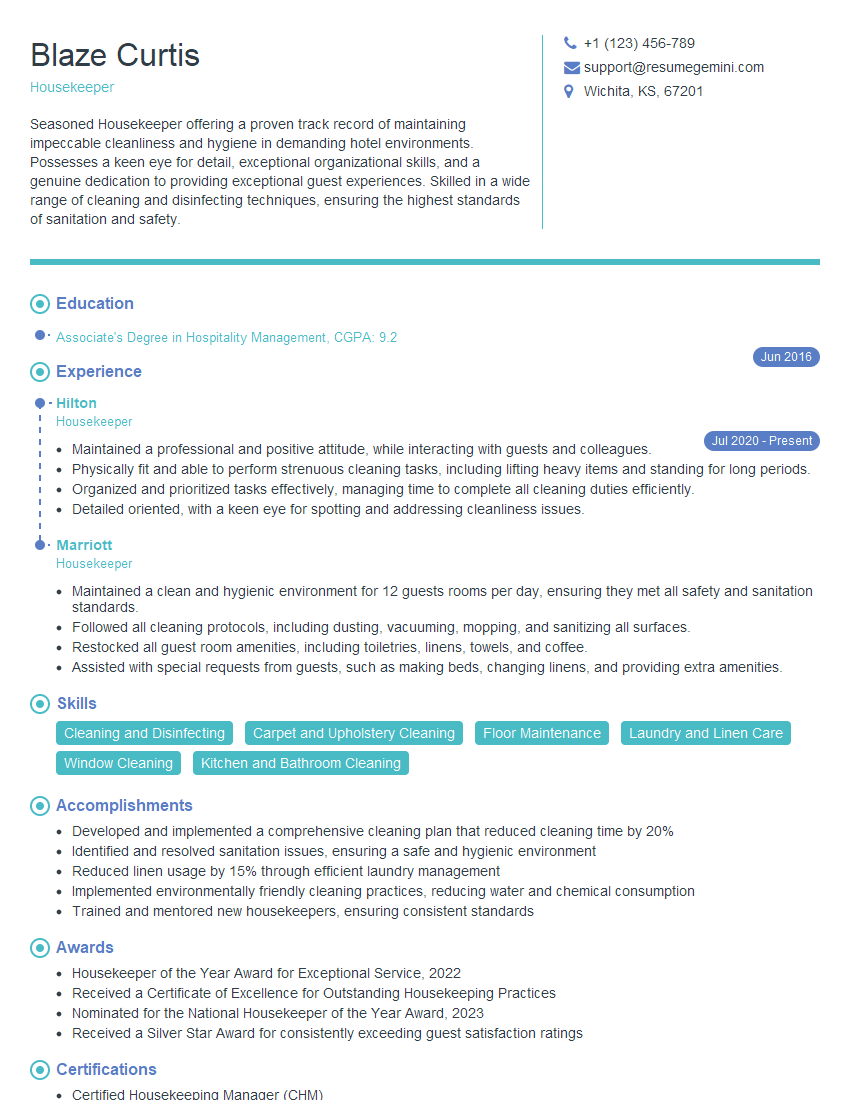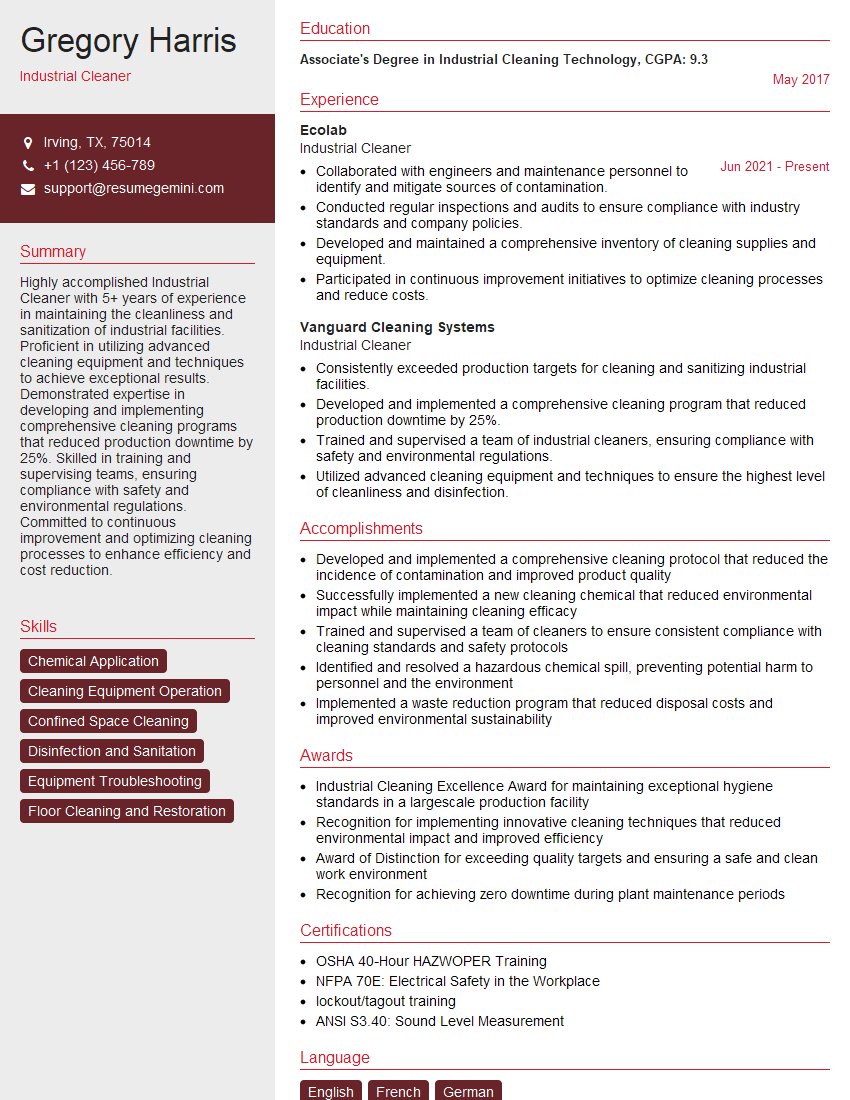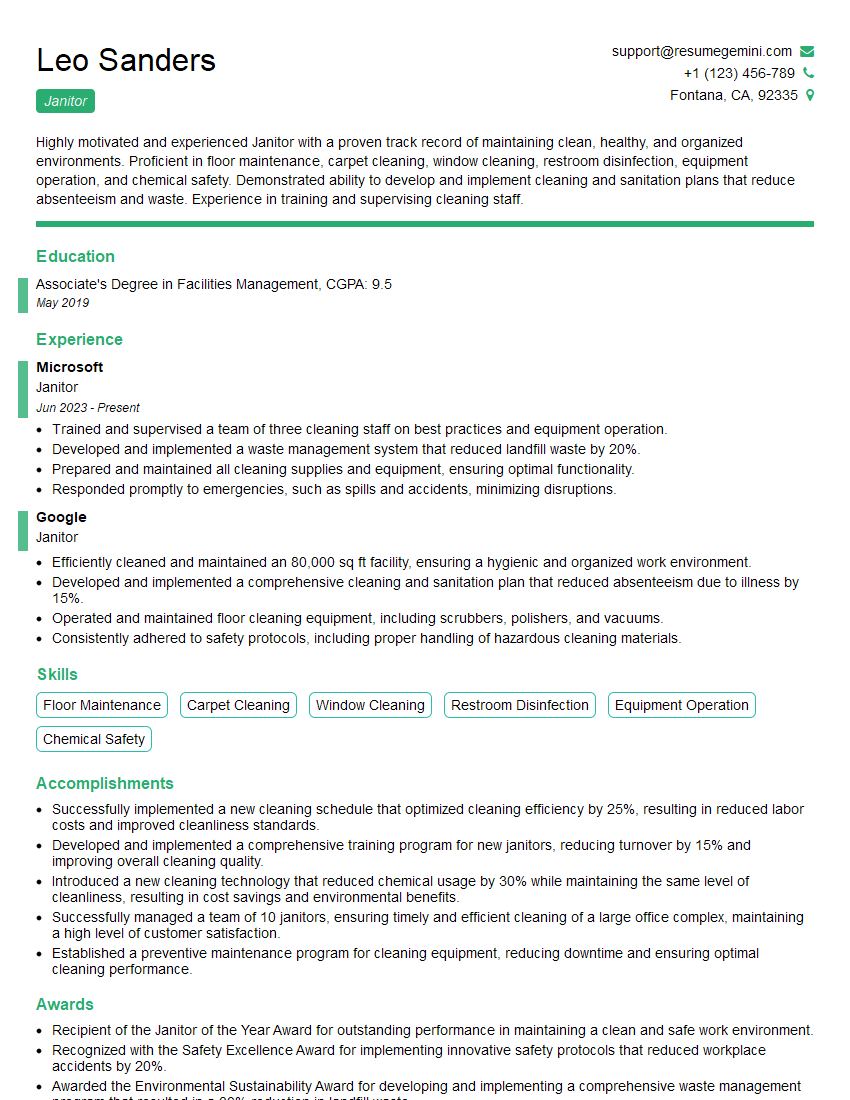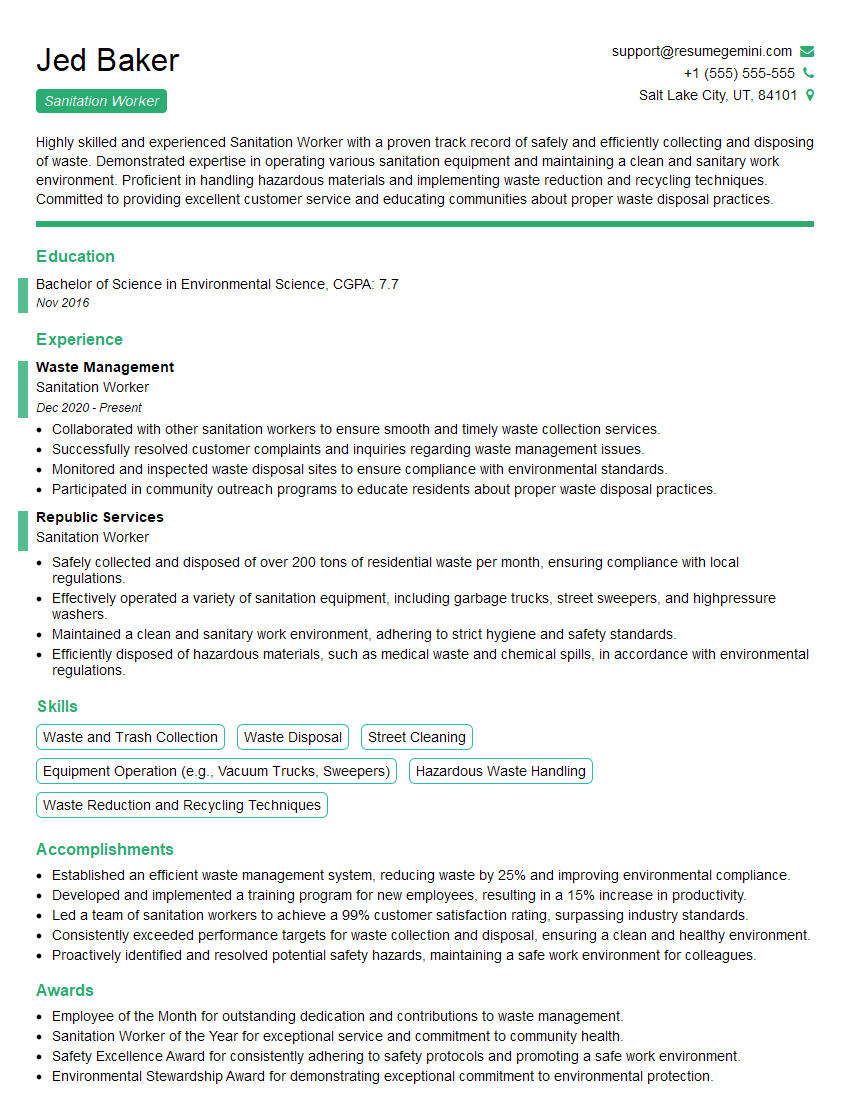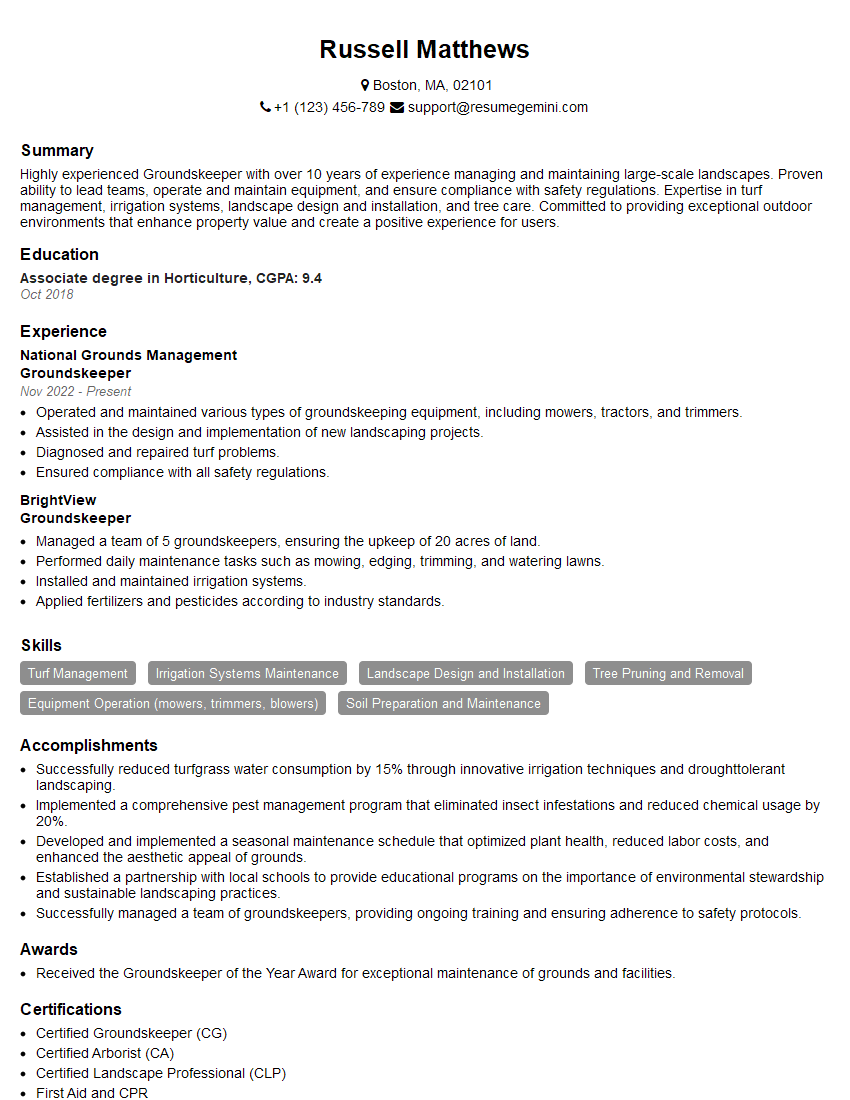Unlock your full potential by mastering the most common Performing routine maintenance and cleaning interview questions. This blog offers a deep dive into the critical topics, ensuring you’re not only prepared to answer but to excel. With these insights, you’ll approach your interview with clarity and confidence.
Questions Asked in Performing routine maintenance and cleaning Interview
Q 1. Describe your experience with preventative maintenance procedures.
Preventative maintenance is all about proactively addressing potential issues before they become major problems. Think of it like regular check-ups for your car – much better to change the oil before the engine seizes! My experience encompasses a wide range of procedures, including:
- Regular equipment inspections: I meticulously inspect cleaning equipment like vacuum cleaners, floor buffers, and pressure washers for signs of wear and tear, checking cords for damage, ensuring proper functionality of all components and replacing worn brushes or belts as needed. For example, I recently noticed a slight wobble in a floor buffer and replaced the worn bearings, preventing potential damage to floors and injury to myself.
- Scheduled cleaning tasks: Beyond daily cleaning, I plan and execute deeper cleaning tasks on a regular schedule. This could include things like deep-cleaning carpets, sanitizing kitchen equipment, or waxing floors, all done according to manufacturers’ recommendations and best practices. For example, I developed a monthly deep-cleaning schedule for a large office building that significantly reduced the incidence of clogs in the drainage system.
- Filter replacements and fluid changes: This is critical for many pieces of equipment. I maintain a schedule for replacing HEPA filters in vacuums, changing oil in floor buffers, and checking fluid levels in pressure washers. Ignoring this can lead to reduced efficiency and equipment failure.
By consistently performing these preventative maintenance tasks, I significantly reduce downtime, extend the lifespan of equipment, and contribute to a safer, more efficient work environment.
Q 2. What safety protocols do you follow while performing cleaning tasks?
Safety is my top priority. I follow a strict set of protocols, including:
- Proper Personal Protective Equipment (PPE): This includes wearing gloves appropriate for the cleaning agents used (e.g., nitrile gloves for harsh chemicals), safety glasses to protect my eyes from splashes, and steel-toe boots for foot protection. I also use respirators when working with potentially airborne particles or strong cleaning agents.
- Hazard communication and labeling: I ensure that all cleaning agents are properly labeled and stored according to manufacturer guidelines and OSHA regulations. I am familiar with the Safety Data Sheets (SDS) for every chemical I use, understanding the potential hazards and necessary precautions.
- Ergonomic practices: I utilize proper lifting techniques and avoid overexertion to prevent injuries. I also use ergonomic tools and equipment whenever possible to minimize strain and fatigue.
- Awareness of surroundings: I am always aware of my surroundings, making sure to keep walkways clear and free of hazards, and using caution around electrical equipment and wet floors.
- Emergency procedures: I know and adhere to the emergency procedures of the workplace, including the location and use of fire extinguishers, emergency exits, and reporting mechanisms.
For example, I recently noticed a spill of a corrosive chemical. I immediately cordoned off the area, donned appropriate PPE, and carefully cleaned the spill following the SDS instructions. The correct procedures were always followed for every task.
Q 3. How do you prioritize tasks when faced with multiple cleaning/maintenance requests?
When faced with multiple requests, I prioritize tasks based on urgency, impact, and safety. I use a system that considers:
- Urgency: Tasks that pose immediate safety risks (e.g., a hazardous spill) take precedence over routine cleaning.
- Impact: Tasks that significantly impact operations or client experience (e.g., cleaning a heavily used restroom) are prioritized over less critical tasks.
- Dependencies: Some tasks depend on others; for example, carpet cleaning may need to wait until furniture has been moved. I plan accordingly.
I often use a task management system, either a physical checklist or a digital application, to track requests, assign priorities, and monitor progress. This allows me to efficiently manage my workload and ensure that all tasks are completed effectively and in a timely manner. I regularly review and adjust this system to meet the changing demands of the workplace.
Q 4. What cleaning agents and equipment are you proficient in using?
I am proficient in using a wide range of cleaning agents and equipment, including:
- Cleaning agents: I have experience with various disinfectants, sanitizers, degreasers, floor cleaners (both neutral and alkaline), glass cleaners, and specialized cleaning products for different surfaces (e.g., stainless steel, marble, wood).
- Equipment: I am skilled in the operation and maintenance of various equipment, such as vacuum cleaners (upright, canister, wet/dry), floor buffers (orbital and cylindrical), carpet extractors, pressure washers, steam cleaners, and various hand tools (e.g., mops, squeegees, brushes).
I always follow the manufacturer’s instructions for using each cleaning agent and piece of equipment to ensure effectiveness and safety. For example, I know the importance of using the correct dilution ratio for disinfectants to ensure they are effective against harmful pathogens.
Q 5. Explain your experience with troubleshooting minor equipment malfunctions.
Troubleshooting minor equipment malfunctions is a regular part of my work. My approach involves:
- Identify the problem: I start by carefully observing the malfunction – what is the equipment doing (or not doing)? For instance, if the vacuum cleaner isn’t sucking, is it a clogged filter or a broken belt?
- Consult manuals and resources: I refer to the equipment’s manual or online resources to identify potential causes and solutions. Many times, a simple fix is detailed in the manual.
- Basic repairs: I am capable of performing basic repairs, such as replacing belts, filters, or light bulbs. I also know how to unclog pipes and hoses.
- Escalate if necessary: If the problem is beyond my expertise, I immediately report it to the appropriate personnel for professional repair. Safety is always the priority, and I don’t attempt repairs that could potentially cause further damage or injury.
Recently, a floor buffer stopped working midway through waxing. By checking the power cord and the breaker, I quickly identified a blown fuse, which I replaced, allowing me to resume the task without significant delay.
Q 6. How do you handle hazardous materials during cleaning or maintenance?
Handling hazardous materials requires meticulous attention to safety. My procedure involves:
- Proper PPE: Always using the appropriate personal protective equipment as specified on the Safety Data Sheet (SDS) of the material.
- SDS review: Familiarizing myself with the specific hazards and handling instructions outlined in the SDS before working with any hazardous material.
- Proper storage: Storing hazardous materials in designated areas, correctly labeled, and following any specific storage requirements mentioned in the SDS.
- Spill response: Having a plan in place to address any spills or leaks, including the use of appropriate neutralizing agents and cleanup procedures (all as detailed in the relevant SDS).
- Waste disposal: Properly disposing of hazardous waste according to local regulations and guidelines.
I always follow the regulations and procedures concerning hazardous materials, ensuring the safety of myself and others. For instance, when dealing with bleach, I ensure adequate ventilation to prevent inhalation hazards.
Q 7. Describe your experience with floor care (e.g., stripping, waxing, buffing).
Floor care is a significant part of my expertise. My experience encompasses the entire process:
- Stripping: Removing old wax and finish from floors using appropriate chemicals and equipment, ensuring the floor is properly prepared for the new application.
- Waxing: Applying several coats of wax according to the manufacturer’s instructions, ensuring even coverage and allowing sufficient drying time between coats.
- Buffing: Using appropriate buffers to achieve a high-gloss finish, removing excess wax, and maintaining the floor’s shine.
- Maintenance: Regularly cleaning and maintaining the floors using appropriate methods to extend their life and keep them looking their best.
I have experience working with various floor types, including vinyl, hardwood, tile, and concrete. For example, I recently completed the stripping, waxing, and buffing of a large marble floor in a high-traffic area, delivering a lustrous and durable finish.
Q 8. How do you maintain a clean and organized workspace?
Maintaining a clean and organized workspace is crucial for efficiency and safety. My approach is based on a proactive, preventative system, rather than simply reacting to mess. It involves a combination of daily, weekly, and monthly tasks.
- Daily: I start each day by tidying my immediate work area, clearing away clutter like used papers, empty containers, and unnecessary tools. I also wipe down surfaces to prevent the build-up of dust and grime. Think of it like making your bed – a small effort that sets a positive tone for the day.
- Weekly: A more thorough cleaning happens weekly. This includes vacuuming or sweeping the floor, emptying trash cans, and organizing supplies. I also take time to declutter, discarding obsolete items and reorganizing storage spaces. This prevents the accumulation of unnecessary items that could cause hazards.
- Monthly: Monthly maintenance involves more in-depth cleaning. This may include disinfecting surfaces, cleaning out drawers and cabinets, and conducting a more comprehensive inspection for potential maintenance issues. This prevents issues from becoming major problems.
For example, in a previous role, I implemented a color-coded system for cleaning supplies, making it easier for the entire team to locate and use the correct products. This simple change improved both efficiency and the consistency of our cleaning procedures.
Q 9. What is your experience with carpet cleaning techniques?
My experience with carpet cleaning encompasses various techniques, depending on the type of carpet and the level of soiling. I’m proficient in both dry and wet cleaning methods.
- Dry Cleaning: This method is ideal for light cleaning and maintaining carpets between deep cleans. Techniques include vacuuming with appropriate attachments (such as upholstery tools for crevices), using dry cleaning powders or foam cleaners, and employing specialized carpet sweepers.
- Wet Cleaning: Hot water extraction (also known as steam cleaning) is the most common wet cleaning method. This involves using a machine to inject hot water and detergent into the carpet fibers, then extracting the dirty water. I’m also experienced in using bonnet cleaning, which uses a rotary machine with a damp cleaning pad. Choosing the right method depends on the carpet’s material and the type of stain or dirt.
For instance, in one project, I used a combination of dry cleaning and spot treatment to remove stubborn wine stains from a wool carpet. Pre-treating the stains with a specialized cleaning solution before using hot water extraction was key to preserving the carpet’s quality.
Q 10. How do you ensure the safety of occupants during cleaning operations?
Ensuring occupant safety is my top priority. I employ several strategies to achieve this.
- Clear Signage: I always use clear and prominent signage to alert occupants of cleaning operations in progress, specifying areas that are temporarily inaccessible. This is especially important in high-traffic areas.
- Wet Floor Warnings: When working with liquids, I utilize bright yellow “wet floor” signs and caution tape to prevent slips and falls. These signs are placed strategically, both before and within the cleaning area.
- Safe Practices: I use appropriate Personal Protective Equipment (PPE) like gloves, safety glasses, and sturdy shoes. I also carefully handle cleaning chemicals, following the manufacturer’s instructions and storing them securely to prevent accidental spills or exposure.
- Communication: If a cleaning task requires disrupting normal operations, I communicate proactively with occupants, coordinating schedules to minimize inconvenience and maintain safety.
For example, during a large-scale cleaning project in a busy office building, I carefully scheduled my work around peak hours and implemented a color-coded system for cleaning carts to prevent accidental collisions in hallways.
Q 11. What is your experience with window cleaning procedures?
Window cleaning requires precision and attention to detail. My experience includes both interior and exterior cleaning, using various methods.
- Traditional Method: This involves using squeegees, buckets, and cleaning solutions. I’m adept at achieving streak-free results using proper technique – overlapping strokes and maintaining consistent pressure.
- Water-Fed Pole System: For taller windows, I use a water-fed pole system, which provides a reach of several stories. This method uses purified water, eliminating the need for harsh chemicals and producing spotless results.
I also consider the type of window glass and the surrounding environment. For example, delicate or antique windows require a gentler approach, while heavily soiled windows may need pre-treatment. In a recent project, I used the water-fed pole system for a high-rise building, ensuring safety and efficiency by avoiding the use of ladders.
Q 12. How do you track and report maintenance issues?
I meticulously track and report maintenance issues using a combination of digital and physical methods.
- Digital Tracking: I utilize software or apps designed for maintenance tracking. These platforms allow for detailed descriptions of the issue, photographs, location, and priority level. I assign myself or other personnel to address these problems accordingly. Many systems allow for scheduled reminders or follow-ups.
- Physical Reporting: I also maintain physical logs or notebooks, particularly for smaller or less urgent issues. This serves as a backup and can be useful when digital systems are unavailable.
- Communication: Regular reporting to supervisors or management is crucial. I provide updates on the status of maintenance requests, highlighting resolved issues and those needing further attention.
For instance, using a facility management software, I recently logged a faulty light fixture in a hallway and assigned it to the electrical team for repair. The software automatically generated a work order and tracked the progress of the repair, ensuring the issue was promptly addressed.
Q 13. Describe your experience with restroom sanitation procedures.
Restroom sanitation demands rigorous adherence to hygiene protocols. My experience encompasses a comprehensive approach.
- Regular Cleaning: This involves frequent cleaning and disinfecting of all surfaces, including toilets, sinks, floors, and walls. I use appropriate cleaning agents according to manufacturer instructions and ensure thorough rinsing to avoid residue.
- Disinfection: Disinfecting is crucial to eliminate germs and bacteria. I focus on high-touch surfaces such as doorknobs, faucets, and soap dispensers, using EPA-registered disinfectants.
- Replenishment: I regularly replenish soap, paper towels, toilet paper, and hand sanitizer dispensers to maintain a hygienic and functional restroom environment.
- Odor Control: I address unpleasant odors using air fresheners or odor neutralizers. Addressing the source of the odor is always my priority. Proper ventilation and cleaning are crucial in odor control.
I adhere strictly to health and safety regulations, always wearing appropriate PPE and following proper disposal methods for used cleaning materials. For instance, in a previous role, I implemented a daily checklist for restroom cleaning, ensuring consistency and thoroughness across all restroom facilities.
Q 14. How do you handle spills and other unexpected cleaning situations?
Handling spills and unexpected cleaning situations requires quick thinking and efficient action. My approach is based on immediate response and preventative measures.
- Immediate Action: My first priority is safety. I will secure the area and prevent further spread by containing the spill with absorbent materials. I’ll then assess the nature of the spill (e.g., liquid, solid, hazardous material) to determine the appropriate cleaning method.
- Appropriate Cleaning Products: I use the correct cleaning solution for the type of spill. For example, different products are used for grease spills compared to chemical spills. Always check the MSDS sheet for hazardous materials.
- Documentation: I document the incident, including the type of spill, location, date, time, and any actions taken. This documentation is important for record-keeping and potential future reference.
- Preventative Measures: Following the cleanup, I consider the underlying causes that might have led to the spill and identify ways to prevent similar incidents in the future. This could involve improved storage, better signage, or staff training.
For example, I once responded quickly to a coffee spill in a busy office, using absorbent pads to contain the spill before carefully cleaning the area with a suitable solution to prevent slipping hazards. I then suggested installing non-slip mats in that area to prevent future spills.
Q 15. What is your experience with high-pressure cleaning equipment?
I have extensive experience operating various high-pressure cleaning equipment, from smaller, handheld units ideal for detailed work to larger, industrial-grade machines used for exterior cleaning of buildings or large machinery. My experience encompasses understanding the different nozzle types and pressures required for various surfaces and materials. For instance, a delicate surface like marble might require a lower pressure and wider spray pattern compared to removing stubborn grime from concrete, which would necessitate higher pressure and a more concentrated nozzle. Safety is paramount; I’m proficient in all safety protocols, including proper PPE (personal protective equipment) usage and understanding the potential hazards associated with high-pressure water jets.
I’m also familiar with maintaining these machines, including regularly checking pressure gauges, cleaning filters, and identifying potential mechanical issues. During my time at [Previous Company Name], I was responsible for the upkeep of three high-pressure washers, ensuring their optimal performance and longevity. One instance involved diagnosing a malfunctioning pressure regulator – through systematic troubleshooting, I identified the faulty component and initiated the repair, minimizing downtime.
Career Expert Tips:
- Ace those interviews! Prepare effectively by reviewing the Top 50 Most Common Interview Questions on ResumeGemini.
- Navigate your job search with confidence! Explore a wide range of Career Tips on ResumeGemini. Learn about common challenges and recommendations to overcome them.
- Craft the perfect resume! Master the Art of Resume Writing with ResumeGemini’s guide. Showcase your unique qualifications and achievements effectively.
- Don’t miss out on holiday savings! Build your dream resume with ResumeGemini’s ATS optimized templates.
Q 16. How do you ensure the proper disposal of waste materials?
Proper waste disposal is crucial for both environmental responsibility and legal compliance. My approach involves a multi-step process. First, I meticulously segregate waste materials into designated categories according to their composition (e.g., recyclable plastics, hazardous chemicals, general waste). This segregation ensures that materials are disposed of in an environmentally sound manner and in compliance with local regulations.
Second, I ensure that all hazardous waste, such as cleaning chemicals, is handled according to the manufacturer’s instructions and relevant safety data sheets (SDS). This includes using appropriate containers, labeling them clearly, and documenting disposal procedures. I’m familiar with local regulations concerning hazardous waste disposal and will always utilize licensed disposal services when necessary. For example, I’ve handled the disposal of used solvents following strict protocols outlined in the SDS and local ordinances, ensuring safe and compliant disposal.
Finally, I maintain detailed records of all waste disposal activities, including dates, quantities, and disposal methods. This documentation is essential for auditing purposes and helps track overall waste management efficiency.
Q 17. Describe your experience with inventory management of cleaning supplies.
Effective inventory management of cleaning supplies is critical for maintaining efficient operations and cost control. My experience includes implementing and maintaining inventory systems, including both manual and computerized methods. I’m proficient in tracking stock levels, forecasting demand based on usage patterns, and placing timely orders to avoid stockouts.
I often employ a FIFO (First-In, First-Out) system to manage perishable items like cleaning solutions, ensuring that older products are used before newer ones to prevent spoilage. Moreover, I regularly conduct physical inventory counts to reconcile stock levels with the inventory system, identifying and addressing any discrepancies. At [Previous Company Name], I successfully implemented a new inventory management software that streamlined ordering and reduced our supply costs by 15% in the first year. This involved training colleagues on the system, data entry, and establishing a regular stock-taking schedule.
Q 18. How do you handle customer complaints or concerns regarding cleanliness?
Handling customer complaints or concerns regarding cleanliness requires a professional and empathetic approach. My first step is to listen actively and validate the customer’s concerns. I avoid getting defensive and focus on understanding their perspective. Once I understand the issue, I conduct a thorough investigation to assess the situation objectively.
This may involve inspecting the area in question, reviewing cleaning logs, and interviewing colleagues who may have worked in that area. Depending on the nature of the issue, I might take immediate corrective action, such as re-cleaning the affected area. I then follow up with the customer to confirm that the problem has been resolved to their satisfaction and apologize for any inconvenience caused. For example, I once addressed a customer complaint about a poorly cleaned restroom by immediately recleaning the area, addressing the specific concerns raised, and offering a complimentary service in the future. The customer was very appreciative of my responsiveness and proactive problem-solving.
Q 19. Explain your understanding of OSHA regulations related to cleaning and maintenance.
I have a solid understanding of OSHA (Occupational Safety and Health Administration) regulations concerning cleaning and maintenance. This includes awareness of the Hazard Communication Standard (HazCom), which mandates the proper labeling, handling, and training related to hazardous chemicals. I’m also familiar with regulations concerning personal protective equipment (PPE), such as gloves, eye protection, and respiratory protection, depending on the task and the chemicals used.
Furthermore, I understand the regulations pertaining to workplace safety, including proper use of equipment, safe handling of cleaning solutions, and the importance of reporting any accidents or near misses immediately. My experience includes attending OSHA compliance training and ensuring that all cleaning procedures adhere to these standards. For instance, I always ensure that MSDS (Material Safety Data Sheets) are readily available for all cleaning chemicals and that team members are trained on their proper use and safety precautions.
Q 20. What is your experience with scheduling and coordinating maintenance tasks?
Scheduling and coordinating maintenance tasks requires careful planning and organization. My approach begins with creating a detailed maintenance schedule, considering the frequency of tasks based on their importance and the potential impact of neglect. I utilize various tools, including scheduling software and spreadsheets, to track tasks, deadlines, and assigned personnel.
I prioritize tasks based on urgency and impact, ensuring that critical maintenance activities are addressed promptly. For instance, a malfunctioning HVAC system would take precedence over routine carpet cleaning. I also communicate effectively with colleagues to coordinate efforts and avoid scheduling conflicts. I proactively identify potential issues and incorporate preventative maintenance into the schedule to minimize unexpected disruptions. At my previous role, I streamlined the maintenance schedule by 20% through better prioritization and task allocation resulting in increased operational efficiency.
Q 21. How do you stay updated on the latest cleaning techniques and technologies?
Staying updated on the latest cleaning techniques and technologies is essential in this field. I actively participate in professional development activities, including attending industry conferences, webinars, and workshops. I also subscribe to relevant industry publications and online resources to stay informed about new cleaning products, equipment, and best practices.
Furthermore, I’m always exploring new technologies, such as robotic cleaning systems and environmentally friendly cleaning agents. For instance, I recently researched the benefits of using electrostatic sprayers for disinfecting large areas more efficiently. Continuous learning enables me to adapt my approach, enhance efficiency, and provide superior cleaning services.
Q 22. Describe your experience with using computerized maintenance management systems (CMMS).
My experience with Computerized Maintenance Management Systems (CMMS) is extensive. I’ve utilized various platforms, including UpKeep, Fiix, and MPulse, to schedule preventative maintenance, track work orders, manage inventory, and generate reports. For example, in my previous role at [Previous Company Name], I used UpKeep to schedule routine cleaning of HVAC systems, ensuring timely filter changes and preventative maintenance to avoid costly repairs. The CMMS allowed me to track the completion of these tasks, monitor equipment lifespan, and identify potential issues before they escalated. I’m proficient in using CMMS software to input data accurately, generate reports for management, and collaborate with colleagues to ensure efficient maintenance workflows. I’m also adept at using the reporting features to identify trends and patterns in equipment failure, allowing for proactive maintenance planning.
Q 23. How do you maintain a professional appearance and demeanor while performing cleaning tasks?
Maintaining a professional appearance and demeanor while performing cleaning tasks is crucial. It involves more than just wearing a clean uniform; it’s about projecting a sense of competence and respect. This begins with adhering to a strict dress code – always wearing clean, appropriate clothing, and ensuring my uniform is free from stains or damage. I also maintain personal hygiene meticulously. Beyond appearance, professional demeanor includes being courteous and respectful to everyone I interact with, whether it’s a client, colleague, or building occupant. I communicate clearly and professionally, explaining my work and addressing any concerns promptly and respectfully. I’m mindful of noise levels and minimize disruptions, and I always clean up after myself, leaving workspaces neat and tidy. For instance, if I’m cleaning an office, I’ll always ensure that confidential documents are treated with the utmost respect and are never left unattended.
Q 24. What is your experience with pest control procedures?
My experience with pest control procedures involves understanding preventative measures and recognizing pest infestations. I’m familiar with identifying common pests and knowing the appropriate response. This includes understanding the importance of sanitation in preventing pest infestations – ensuring trash is properly disposed of, spills are cleaned immediately, and food is stored correctly. I also know when to contact professional pest control services. For example, if I discover a significant ant infestation or signs of rodent activity, I don’t attempt to handle it myself. Instead, I immediately report the issue to the appropriate personnel and follow established procedures for pest control intervention. I’m trained in identifying signs of pest infestation, such as droppings, nests, or damage to property, and I understand the importance of adhering to safety protocols when dealing with potential pest control issues.
Q 25. How do you assess the severity of a maintenance issue and decide on a course of action?
Assessing the severity of a maintenance issue involves a systematic approach. I start by identifying the problem, its location, and potential impact. Then, I consider the urgency, assessing whether it poses an immediate safety hazard, impacts functionality, or may lead to further damage if left unaddressed. This assessment often involves checking existing documentation or consulting with colleagues if needed. For instance, a dripping faucet might seem minor, but if left unaddressed, it could lead to water damage. I’d prioritize this over a minor scratch on a wall. For more complex issues, I’d document my findings, photograph the problem, and relay information to supervisors for further evaluation and guidance. My decision-making process emphasizes safety, minimizing disruption, and cost-effectiveness. I always prioritize safety first, even if it means delaying a less critical task.
Q 26. Describe your experience working independently and as part of a team.
I’m equally comfortable working independently and as part of a team. Working independently requires strong self-discipline and organizational skills, which I’ve honed through years of experience handling tasks with minimal supervision. I’m adept at prioritizing tasks, managing my time effectively, and ensuring all deadlines are met. However, I thrive in a team environment. I believe that collaboration enhances efficiency and problem-solving. My experience includes working with various teams, contributing ideas, and supporting colleagues to achieve shared objectives. For instance, during a large-scale cleaning project in a hospital setting, I worked seamlessly with a team of cleaners, ensuring that all areas were cleaned thoroughly and efficiently while adhering to strict hygiene protocols. I value open communication and mutual respect in team settings.
Q 27. What are your salary expectations for this role?
My salary expectations for this role are in the range of $[Lower Bound] to $[Upper Bound] annually. This range is based on my experience, skills, and the responsibilities associated with this position. I am open to discussing this further and am confident that my contributions will justify this compensation.
Q 28. Do you have any questions for me?
Yes, I have a few questions. First, could you elaborate on the specific training opportunities available for this role? Second, what are the company’s expectations regarding career progression within the maintenance and cleaning department? Finally, could you provide more details on the team I would be working with and the work culture within the department?
Key Topics to Learn for Performing Routine Maintenance and Cleaning Interviews
- Safety Procedures and Regulations: Understanding and adhering to workplace safety protocols, including the proper handling of cleaning chemicals and equipment. This includes knowing relevant OSHA or industry-specific regulations.
- Cleaning Techniques and Methods: Mastering various cleaning techniques for different surfaces and materials (e.g., disinfecting, sanitizing, polishing, vacuuming). Practical application includes demonstrating knowledge of appropriate cleaning agents for specific tasks and materials.
- Equipment Maintenance and Operation: Knowing how to operate and maintain cleaning equipment (e.g., vacuum cleaners, floor buffers, pressure washers) safely and effectively. This includes basic troubleshooting and reporting malfunctioning equipment.
- Inventory Management: Understanding the importance of maintaining adequate stock levels of cleaning supplies and reporting low stock levels to supervisors.
- Time Management and Efficiency: Demonstrating the ability to plan and complete cleaning tasks efficiently within allotted timeframes. This might include prioritizing tasks and optimizing cleaning routes.
- Record Keeping and Reporting: Maintaining accurate records of completed tasks, supplies used, and any identified maintenance issues. This is crucial for demonstrating accountability and identifying potential problems.
- Problem-solving and Adaptability: Being able to identify and resolve unexpected cleaning challenges or adapt to changing priorities and work environments.
Next Steps
Mastering routine maintenance and cleaning skills opens doors to diverse and rewarding career opportunities, offering stability and potential for advancement. A strong resume is your key to unlocking these opportunities. Creating an ATS-friendly resume significantly increases your chances of getting noticed by potential employers. ResumeGemini is a trusted resource to help you build a professional and impactful resume that showcases your skills and experience effectively. We provide examples of resumes tailored to the Performing Routine Maintenance and Cleaning field to help you get started. Take the next step toward your career success today!
Explore more articles
Users Rating of Our Blogs
Share Your Experience
We value your feedback! Please rate our content and share your thoughts (optional).
What Readers Say About Our Blog
Hi, I’m Jay, we have a few potential clients that are interested in your services, thought you might be a good fit. I’d love to talk about the details, when do you have time to talk?
Best,
Jay
Founder | CEO



